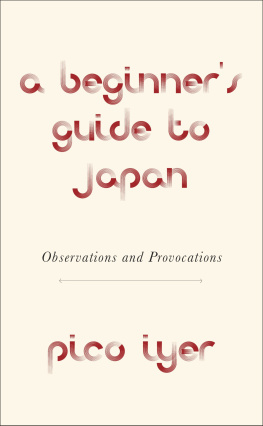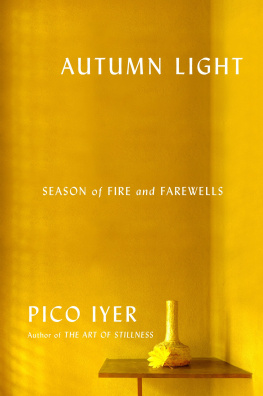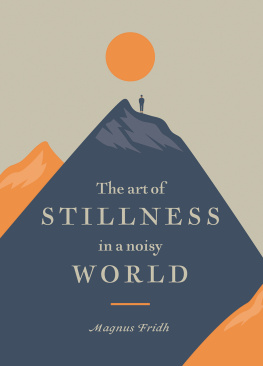Thank you for downloading this TED Books eBook.
Join our mailing list and get updates on new releases, deals, bonus content and other great books from TED Books and Simon & Schuster.
C LICK H ERE T O S IGN U P
or visit us online to sign up at
eBookNews.SimonandSchuster.com
TABLE OF CONTENTS
For Sonny Mehta, who has taught me, and so many others, about art, stillness, and the relation between them.
If I ever go looking for my hearts desire again, I wont look any further than my own backyard. Because if it isnt there, I never really lost it to begin with.
Dorothy, The Wizard of Oz
Introduction
Going Nowhere
The sun was scattering diamonds across the ocean as I drove toward the deserts of the east. Leonard Cohen, my hero since boyhood, was singing so long to Marianne on my sound system when I turned onto the snarl of freeways that clog and clutter central Los Angeles. The sharp winter sun disappeared behind a wall of gray for more than an hour, and then at last I drew out again into the clear.
Turning off the freeway, I followed a riddle of side streets onto a narrower road, all but empty, that snaked up into the high, dark San Gabriel Mountains. Very soon all commotion fell away. Los Angeles simplified itself into a silhouette of peaks in the distance.
High upsigns prohibiting the throwing of snowballs now appeared along the roadI came to a cluster of rough cabins scattered across a hillside. A small man in his sixties, stooped and shaven-headed, stood waiting for me in a rough parking lot. As soon as I got out of my car, he offered a deep ceremonial bowthough wed never met beforeand insisted on carrying my things into the cabin where I was to stay for the next many days. His dark and threadbare monastic robes flew around him in the wind.
Once inside the shelter of the room, the monk started cutting up some freshly baked bread, to console me for my long drive. He put on a kettle for tea. He told me he had a wife for me if I wanted one (I didnt; I had one on the way).
Id come up here in order to write about my hosts near-silent, anonymous life on the mountain, but for the moment I lost all sense of where I was. I could hardly believe that this rabbinical-seeming gentleman in wire-rimmed glasses and wool cap was in truth the singer and poet whod been renowned for thirty years as an international heartthrob, a constant traveler, and an Armani-clad man of the world.
Leonard Cohen had come to this Old World redoubt to make a lifean artout of stillness. And he was working on simplifying himself as fiercely as he might on the verses of one of his songs, which he spends more than ten years polishing to perfection. The week I was visiting, he was essentially spending seven days and nights in a bare meditation hall, sitting stock-still. His name in the monastery, Jikan, referred to the silence between two thoughts.
The rest of the time he largely spent doing odd jobs around the property, cleaning dishes in the kitchen and, most of all, tending to the Japanese abbot of the Mt. Baldy Zen Center, Joshu Sasaki, then eighty-eight years old. Cohen ended up sitting still with his elderly friend for more than forty years.
One eveningfour in the morning, the end of DecemberCohen took time out from his meditations to walk down to my cabin and try to explain what he was doing here.
Sitting still, he said with unexpected passion, was the real deep entertainment he had found in his sixty-one years on the planet. Real profound and voluptuous and delicious entertainment. The real feast that is available within this activity.
Was he kidding? Cohen is famous for his mischief and ironies.
He wasnt, I realized as he went on. What else would I be doing? he asked. Would I be starting a new marriage with a young woman and raising another family? Finding new drugs, buying more expensive wine? I dont know. This seems to me the most luxurious and sumptuous response to the emptiness of my own existence.
Typically lofty and pitiless words; living on such close terms with silence clearly hadnt diminished his gift for golden sentences. But the words carried weight when coming from one who seemed to have tasted all the pleasures that the world has to offer.
Being in this remote place of stillness had nothing to do with piety or purity, he assured me; it was simply the most practical way hed found of working through the confusion and terror that had long been his bedfellows. Sitting still with his aged Japanese friend, sipping Courvoisier, and listening to the crickets deep into the night, was the closest hed come to finding lasting happiness, the kind that doesnt change even when life throws up one of its regular challenges and disruptions.
Nothing touches it, Cohen said, as the light came into the cabin, of sitting still. Then he remembered himself, perhaps, and gave me a crinkly, crooked smile. Except if youre courtin, he added. If youre young, the hormonal thrust has its own excitement.
Going nowhere, as Cohen described it, was the grand adventure that makes sense of everywhere else.
Sitting still as a way of falling in love with the world and everything in it; Id seldom thought of it like that. Going nowhere as a way of cutting through the noise and finding fresh time and energy to share with others; Id sometimes moved toward the idea, but it had never come home to me so powerfully as in the example of this man who seemed to have everything, yet found his happiness, his freedom, in giving everything up.
Late one night, as my gracious host tried to instruct me in the proper way of sitting in the lotus positionrigorous but relaxedI couldnt find the words to tell him that Id never been tempted to meditate. As one whod been crossing continents alone since the age of nine, Id always found my delight in movement; Id even become a travel writer so that my business and my pleasure could become one.
Yet, as Cohen talked about the art of sitting still (in other words, clearing the head and stilling the emotions)and as I observed the sense of attention, kindness, and even delight that seemed to arise out of his life of going nowhereI began to think about how liberating it might be for any of us to give it a try. One could start just by taking a few minutes out of every day to sit quietly and do nothing, letting what moves one rise to the surface. One could take a few days out of every season to go on retreat or enjoy a long walk in the wilderness, recalling what lies deeper than the moment or the self. One could even, as Cohen was doing, try to find a life in which stage sets and performances disappear and one is reminded, at a level deeper than all words, how making a living and making a life sometimes point in opposite directions.
The idea has been around as long as humans have been, of course; the poets of East Asia, the philosophers of ancient Greece and Rome, regularly made stillness the center of their lives. But has the need for being in one place ever been as vital as it is right now? After a thirty-year study of time diaries, two sociologists found that Americans were actually working fewer hours than we did in the 1960s, but we feel as if were working more. We have the sense, too often, of running at top speed and never being able to catch up.











